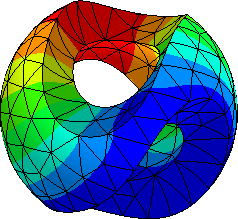8. Beams and Plates#
If one spatial dimension of a domain \(\Omega=[0,1]^2\times[-t/2,t/2]\) is small compared to the other directions, \(t \ll 1\), we have the following options
Use a uniform mesh with an enormous amount of elements
Use anisotropic elements
Make a dimension reduction and only mesh the two-dimensional domain \([0,1]^2\times \{0\}\)
The first option is inefficient as we would waste a lot of elements. The second option can easily lead to locking problems if the thickness \(t\) is small. Therefore, the third option is commonly considered, where the 3D elasticity problem is reduced to a two-dimensional plate problem.
If two directions are small compared to the third one, we can apply a dimension reduction to one-dimensional beams.
In this chapter we first derive the Reissner-Mindlin and Kirchhoff-Love plate equations. Then, we present the Timschenko and Euler-Bernoulli beam and discuss the arising problems of shear locking or how to handle a fourth order problem as a mixed problem. After this, locking-free and stable formulations of the Kirchhoff-Love plate via Hellan-Herrmann-Johnson (HHJ) elements and Reissner-Mindlin plates with the tangential-displacement-normal-normal-stress continuous (TDNNS) elements are considered:
